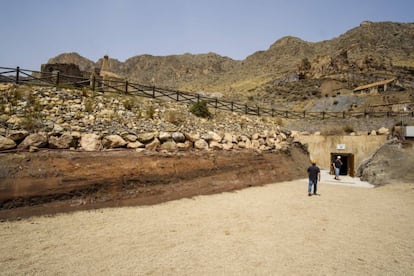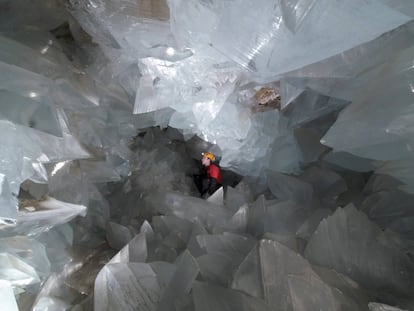The world’s biggest accessible geode opens in southern Spain
Reduced groups will be able to view the giant gypsum crystals that were discovered 20 years ago in Pulpí, Almería
For the man who discovered a giant geode 20 years ago in Pilar de Jaravía, located in the municipality of Pulpí, in Spain’s southern province of Almería, its upcoming opening to the public on August 5 will be a moment to be treasured.
It’s a dream come true for me
Javier García Guinea, CSIC
“It’s a dream come true for me,” says Javier García Guinea, a research professor at the Spanish National Research Council (CSIC) who carried out the first analysis of mineral samples from the giant gypsum crystals found inside a cavity by members of the Madrid Mineralogist Group in 1999. It is he who has been mainly responsible for making it accessible to the public.
Geodes are cavities in the rock that are typically lined with quartz, calcite or gypsum crystals, formed quite simply from a recipe of water, minerals and lots of time.
Pulpí’s is now the biggest accessible geode in the world – the largest one is in Naica in Mexico, but temperatures of 50ºC and a difficult location make it impossible to visit.
As one of the first people to show up at the old abandoned mine after the discovery of the geode within, García Guinea was among those who persuaded Pulpí’s mayor, María Dolores Muñoz, to take measures to prevent the translucent crystals from being plundered.

A committee of representatives from the regional government of Andalusia, the University of Almería, the CSIC and the local council considered several less viable and more expensive ideas to make the public aware of the site’s existence, but they were finally convinced that opening it for guided tours was the most practical and desirable solution.
Working with a budget of €500,000, 700 tons of earth and rubble were removed from the mine to make it safe for visitors, and points of access were constructed, which was one of the biggest challenges to making the crystals a tourist attraction, according to José Ángel Solanilla, a mining engineer and the project manager at Tecminsa, the company that carried out the work. Finally, a cast iron spiral staircase allows the public to descend the 40 meters from the main gallery into the geode itself.
While there has been some concern that tours of the Pulpí mine could lead to the deterioration of the exquisitely translucent crystals within, Tecminsa geologist Francisco Javier Fernández Amo insists that the risk is minimal. He says that the University of Almería has designed a monitoring system that includes alarms if visitor numbers are exceeded, as well as sensors that control temperature, humidity and CO2 levels.
Costing €22 per person, the group tours take a maximum of 12 visitors on a visit of a stretch of 500 meters inside Mina Rica, ending at the massive geode.

In the 20 years since its discovery, scientists have been confirming the crystals’ uniqueness and size – at times as big as two meters – by feeding themselves into awkwardly small nooks and crannies for samples.
Fernández Amo attributes a large part of the formation of the geode at Pulpí to volcanic activity that took place millions of years ago in this area. “Fluids filled with minerals are injected into the layers or cracks,” he explains, adding that first the cavity is formed, and then the mineral deposit within it.
The cavity in Pulpí was possibly created by the karstification of the dolomites that form the local Aguilón mountain range. As far as the crystals are concerned, the theory suggests a mixed karstic-hydrothermal model – in other words, the presence of gypsum and calcite reacting with the hot waters from the volcanic activity.
Unique
In June 2000, this newspaper published the headline ‘Giant geode found in an Almería mine astounds scientists.’ In the story, Javier García Guinea affirmed that a search of international databases had confirmed that nothing like it had previously been found.

“The crystal prisms measuring an average of half a meter cover the entire cavity – floor, roof and walls – which is shaped like a rugby ball. They are far bigger in size than those found in the biggest accessible geodes on Earth, such as the one in the south of Brazil where the amethyst quartz geodes can measure up to a meter in diameter,” he said.
Pulpí’s blue geode is another element of interest, according to Fernández Amo, who explains the hue is due to the presence of strontium, and that the cavity was once over 20 meters in size but was largely destroyed by the mining activities. The site was a working mine from the middle of the 19th century to the end of the 1960s, producing first iron, then silver and lead.
Now part of the mine’s attraction is those “underground cathedrals” that reach a height of up to 40 meters, and the clothing worn by miners in those days, which is now on display. Other elements of note at the mine are the abundance of celestine (a variety of strontium sulfate), barite and siderite. There are also samples of lapis specularis – a transparent gypsum that was used as glass in the windows of Roman palaces.
English version by Heather Galloway.
Tu suscripción se está usando en otro dispositivo
¿Quieres añadir otro usuario a tu suscripción?
Si continúas leyendo en este dispositivo, no se podrá leer en el otro.
FlechaTu suscripción se está usando en otro dispositivo y solo puedes acceder a EL PAÍS desde un dispositivo a la vez.
Si quieres compartir tu cuenta, cambia tu suscripción a la modalidad Premium, así podrás añadir otro usuario. Cada uno accederá con su propia cuenta de email, lo que os permitirá personalizar vuestra experiencia en EL PAÍS.
En el caso de no saber quién está usando tu cuenta, te recomendamos cambiar tu contraseña aquí.
Si decides continuar compartiendo tu cuenta, este mensaje se mostrará en tu dispositivo y en el de la otra persona que está usando tu cuenta de forma indefinida, afectando a tu experiencia de lectura. Puedes consultar aquí los términos y condiciones de la suscripción digital.










































